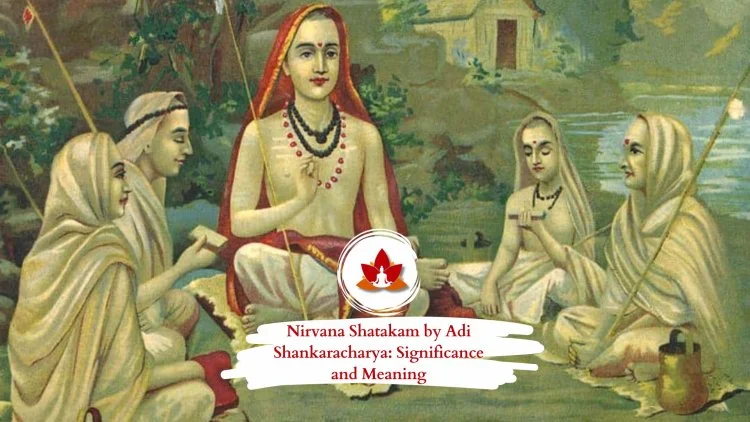Introduction To Nirvana Shatakam
The Nirvana Shatakam, also known as Atma Shatakam, is one of the most profound compositions in the Advaita Vedanta tradition. Written by Adi Shankaracharya, this six-verse hymn beautifully expresses the essence of non-duality and self-realization.

The term “Nirvana” means liberation or the state of absolute freedom from bondage, while “Shatakam” means six verses. Therefore, Nirvana Shatakam literally translates to “The Six Verses on Liberation.” These verses encapsulate the experience of the enlightened self, free from all limitations of body, mind, and identity.
The Historical Background of Nirvana Shatakam
Adi Shankaracharya and His Teachings
Adi Shankaracharya, the great 8th-century philosopher and saint, composed Nirvana Shatakam at a very young age. It is said that when he met his guru, Govindapada, the teacher asked him who he was.
In response, young Shankara spontaneously recited these six verses, declaring his identity as the infinite consciousness rather than the limited physical form. This spontaneous revelation became the Nirvana Shatakam, one of the most powerful summaries of Advaita Vedanta philosophy.
Philosophical Context
The Nirvana Shatakam forms the core of Advaitic thought, emphasizing that the true self (Atman) is beyond the dualities of life — pleasure and pain, birth and death, virtue and sin. The hymn teaches that liberation comes through the realization of one’s own infinite nature, which transcends the physical and mental realms.
The Essence and Meaning of Nirvana Shatakam
Beyond the Body and Mind
Each verse of the Nirvana Shatakam begins with the negation of what one is not — “I am not the mind, intellect, ego, or memory.” This approach, called Neti Neti (“not this, not this”), helps remove all false identities associated with the body, emotions, and thoughts. The verses gradually lead the seeker to recognize their true self as pure consciousness — eternal, unchanging, and blissful.
The Declaration of Oneness
In the concluding lines of every verse, Adi Shankaracharya repeats the powerful affirmation — “Chidananda Rupa Shivoham Shivoham”, meaning “I am the form of consciousness and bliss, I am Shiva, I am Shiva.”
Here, Shiva does not refer to the deity in form, but the universal consciousness that pervades everything. Thus, Nirvana Shatakam declares the unity of all existence and the dissolution of individuality in the supreme self.
Structure and Verses of Nirvana Shatakam
Verse 1: Freedom from Mind and Senses
The first verse of Nirvana Shatakam begins by denying association with the mind, intellect, ego, and emotions. It emphasizes that the true self is not bound by the senses or physical experiences. This verse lays the foundation for the seeker’s detachment from mental and sensory identifications.
Verse 2: Beyond Prana and Elements
The second verse negates identification with Prana (life force), five elements (earth, water, fire, air, space), and the body. It conveys that the self is not sustained by breath or matter but exists as the pure witness beyond them.
Verse 3: Transcending Desire and Attachment
Here, Adi Shankaracharya denies attachment to worldly pleasures, family, and possessions. The Nirvana Shatakam teaches that liberation comes when one releases desires and recognizes the self as unbound, pure consciousness.
Verse 4: Beyond Virtue, Sin, and Rituals
The fourth verse asserts that the self is beyond all dualities of virtue and sin, pleasure and pain. Nirvana Shatakam dissolves the need for ritualistic identity, affirming that one’s essence is neither bound by religion nor caste but is the same universal consciousness.
Verse 5: Freedom from Death and Delusion
In this verse, the enlightened self declares that it has no fear of death, nor attachment to life. Nirvana Shatakam expresses a serene detachment from birth and decay, proclaiming the self as eternal and untouched by the cycle of time.
Verse 6: The Ultimate Realization
The final verse concludes with the realization of the absolute truth — “I am without form, without limits, without beginning or end.” The Nirvana Shatakam reaches its peak here, affirming the dissolution of the ego and merging into pure consciousness — Shivoham Shivoham.
Spiritual Significance of Nirvana Shatakam
Path to Self-Realization
The Nirvana Shatakam serves as a practical guide for meditation and self-inquiry. By contemplating the meanings of these verses, seekers can gradually disidentify from the transient and connect with the eternal self. It is not merely a philosophical statement but a living experience of oneness and inner freedom.
Universal Appeal
Though rooted in Hindu philosophy, Nirvana Shatakam transcends religious boundaries. Its universal message of inner peace, detachment, and awareness resonates with people from all spiritual backgrounds. It is a timeless composition that continues to inspire yogis, monks, and seekers worldwide.
Modern Relevance of Nirvana Shatakam
In today’s fast-paced and material-driven world, the Nirvana Shatakam offers a pathway to peace and clarity. It reminds us that our true identity is not defined by roles, possessions, or achievements.
The verses teach mindfulness, detachment, and awareness — qualities that help reduce stress and anxiety. Practicing the meditation on Nirvana Shatakam can lead to inner stillness, emotional balance, and spiritual awakening.
Conclusion
The Nirvana Shatakam stands as a beacon of timeless wisdom, pointing toward the ultimate goal of human life — liberation through self-realization. Each verse dissolves layers of illusion and reveals the eternal truth: “I am not the body or mind, I am pure consciousness — blissful, infinite, and divine.”
Adi Shankaracharya’s Nirvana Shatakam continues to enlighten and guide countless seekers toward the realization of their true nature — the boundless self, Shivoham.